The Best British Christmas Cake
If you’re after the best British Christmas Cake, this is it. This traditional fruit cake is the one my Mum has always made – a recipe she used professionally for years – and it’s rich, moist, and packed with dried fruit. A proper UK Christmas classic, and perfect whether you’re making it ahead to mature, or a bit closer to the big day.
It’s been tested in real home kitchens too, so you can trust it will turn out beautifully, even if it’s your first time making a Christmas Cake.
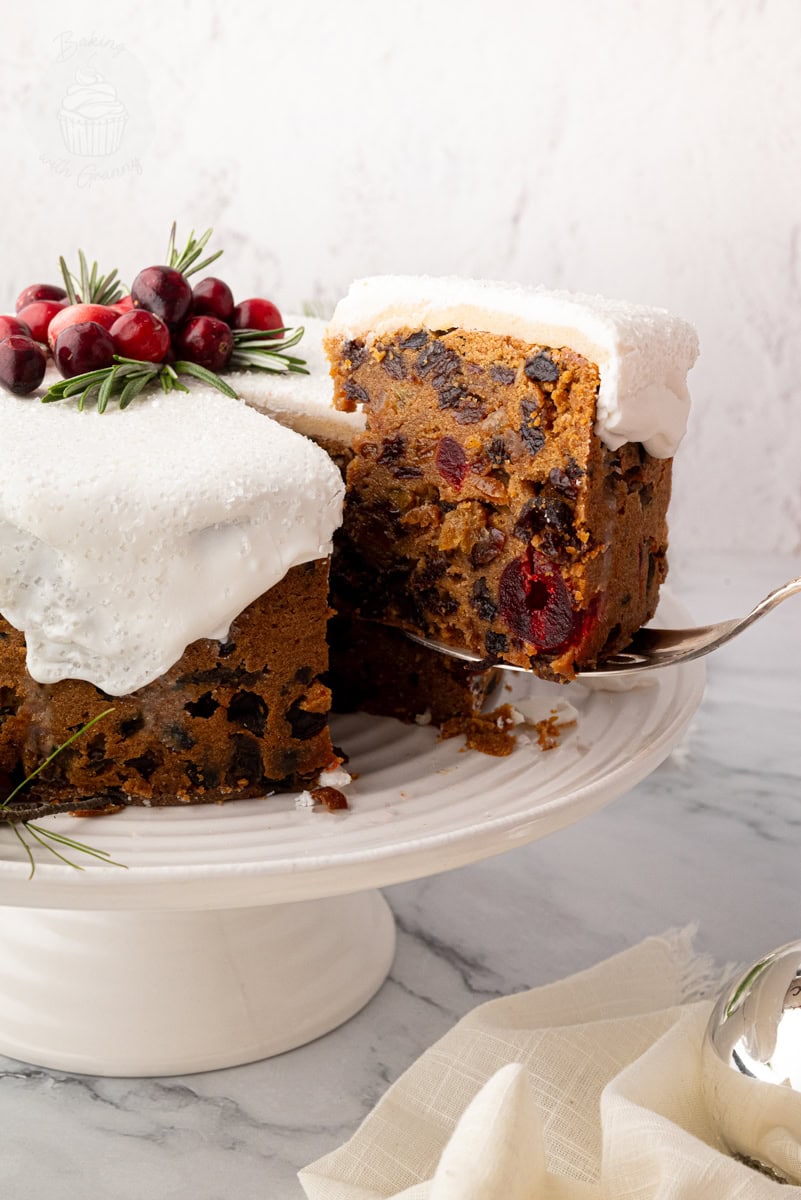
This classic British Christmas Cake tastes every bit as good as it looks, if not better.
It’s the recipe my Mum has always used, and the one she became known for locally. For years, she’d bake dozens of them – selling some and giving many away, and it’s also the very same fruit cake recipe she used for traditional tiered wedding cakes.
The smell alone takes me straight back to my childhood, not to December, funnily enough! But too early summertime, when she would be baking for the wedding season, and the whole house filled with that unmistakable warm, spiced scent of a proper fruit cake in the oven.
This recipe is classic in every way: oodles of dried fruit soaked in brandy or orange juice, soft dark brown sugar for that familiar rich colour, and plenty of cinnamon and mixed spice for warmth. It’s simple, traditional, and wonderfully reliable – the kind of Christmas Cake you can make well ahead of time, on Stir-up Sunday, or much closer to Christmas, if you prefer.
And if you’re baking for a smaller household, a bigger gathering, or making multiple cakes as gifts, you’ll also find my handy quantities guide helpful, to let you scale the recipe up or down without any guesswork.
No Christmas Cake feels complete without its finishing touches. Traditionally, you’d start with a layer of marzipan, and then it’s up to you whether you go for a topping of fondant icing for ease, or go old-school with royal icing instead, if you prefer.
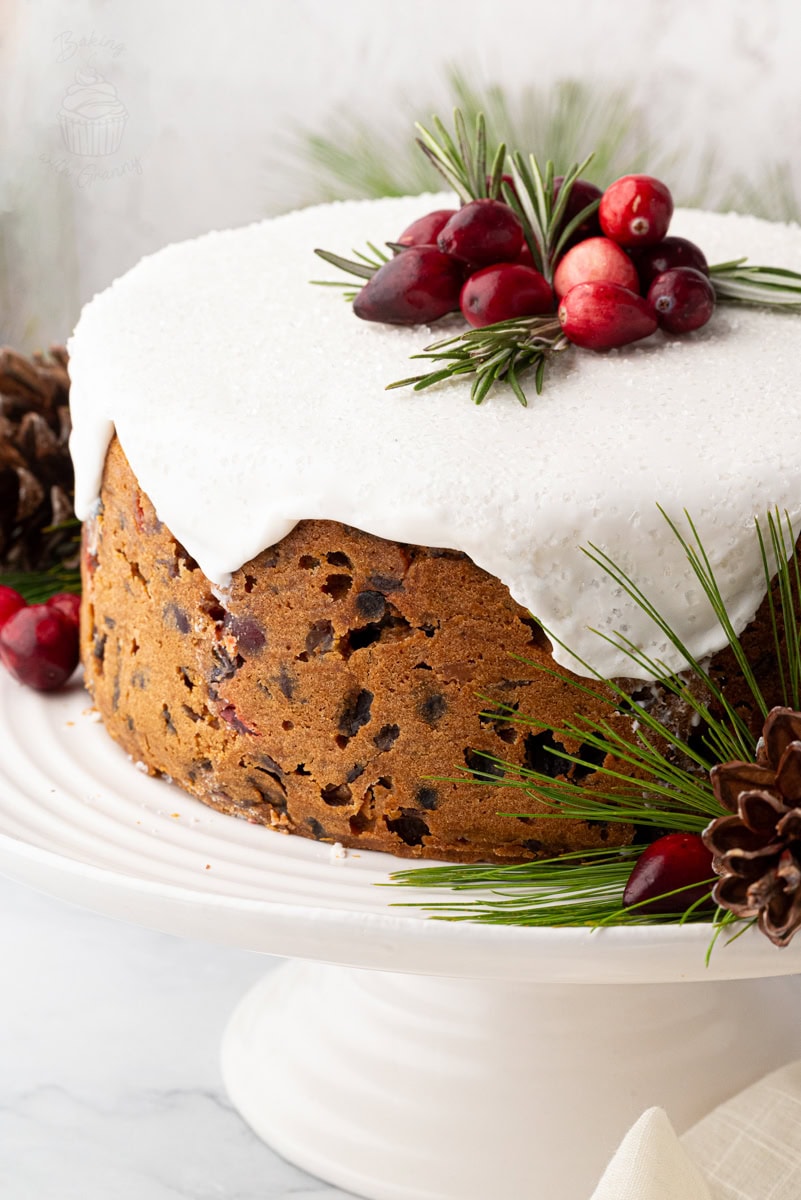
Ingredients for traditional Christmas Cake (8-inch/20cm):
Dried Fruit
The most important element in Granny’s Christmas Cake! As this is a rich fruit cake, a lot of dried fruit is required. I have listed these in individual quantities in the recipe card. However, you can of course use a bag of Mixed Dried Fruit for convenience – just make sure you have the same total amount of dried fruit for your cake size.
Generally speaking, your dried fruit will consist of currants, raisins and sultanas (some bags of mixed dried fruit will also contain your mixed peel), but you can be quite flexible and swap out these dried fruits in varying quantities, or for alternatives if there’s something in particular you aren’t too fond of. I personally love to add some dried cranberries to my Christmas cake!
Love dried fruit bakes? Try my Christmas Pudding, Black Bun and Clootie Dumpling recipes, too!
Glace Cherries
I always think glace cherries look like little jewels when mixed in with the rest of your dried fruits. They add a slightly different texture to your fruits, as well as a complementary candy-like sweetness.
Mixed Peel
What I’ve found from my time using mixed peel in recipes is that it’s a bit like the Marmite of the baking world – you either love it or you hate it. Personally, I love it. And I think it’s a great addition to a rich fruit cake, as it helps add an extra depth in the flavour, whilst also tying in nicely with the orange zest flavours too.
Ground Almonds
I’ve often opted for flaked or blanched almonds in a Christmas cake, but Granny maintains that ground almonds will always reign superior, in terms of overall texture; that’s because they help the cake retain its moisture while it bakes. There’s nothing worse than a dry fruit cake, after all!
Orange Zest
Ok, so. Granny has previously opted for lemon zest in fruit cakes, which I can’t dispute because it does work great too. However, when it comes to Christmas, I feel like orange is always the winning flavour, hands down! (But if you’d prefer lemon zest you can still use that too).
Brandy or Orange Juice
Perhaps the most debated part of a classic British Christmas cake! Now, I have listed Brandy as the alcohol of choice in this recipe, purely because it’s what was written in the recipe Granny gave me. However, that’s not to say it is your only option. Granny will often swap between Brandy, Port, Rum and even Whisky. Basically, you can use whatever your alcoholic beverage of choice is.
But if you want to be somewhat controversial – like me – you don’t have to use alcohol at all.
I’m not really an alcohol drinker, so the idea of buying an expensive spirit, purely to soak some dried fruit for a cake, seems absurd to me. Instead, I use orange juice. And much to my delight, Papa tells me I have made some of the best Christmas cakes (and Black Bun) he’s tasted with this method. And Papa strongly believes whisky should be used in both…and everything.
Also, the amount listed is for soaking your fruit. Should you wish to “feed” your cake after baking, more of your liquid of choice will be required.
Plain Flour
For those who are familiar with any of my other cake recipes, you’ll be used to me saying self-raising flour is generally preferable in cakes. Not for Christmas Cake! This is a rich fruit cake recipe, and so the majority of the mix is made from the dried fruit. Everything else is really just there to bind it together. With that in mind, no raising agents are required, and plain flour is ideal.
Mixed Spice & Ground Cinnamon
These don’t really need any explanation, other than they are the smell and taste of Christmas in a tiny little jar.
Butter or Margarine
Either is fine, it’s just down to personal preference. I like margarine as it’s cheaper and an easy way to omit the dairy from this recipe. Just be sure to use a block margarine as opposed to the spreadable kind – the latter has a higher water content and may alter your baking times.
Soft Dark Brown Sugar
I have decided to list our sugar choice as Soft Dark Brown Sugar; however, this can be flexible to a degree. Granny’s personal favourite sugar for Christmas cakes is a Dark Muscovado, both for flavour and a darker colour. However, Soft Dark Brown Sugar is a cheaper and more convenient option. You can, of course, use a Soft Light Brown Sugar, or even caster sugar; these will change the colour and flavour of your cake quite noticeably, though.
Free-range Eggs
It may seem like this recipe calls for a lot of eggs, but that’s because it makes a lot of cake. Plus, they do a lot of ground work in binding your ingredients together, and with the amount of fruit we are using, a lot of binding is required. The size of your eggs isn’t of great importance, but be sure to use free-range when possible.
International bakers: This is a traditional British Christmas Cake, so ingredients use UK terminology such as grams, Celsius, and ingredients like “mixed spice.” If you’re in the US, Canada, Australia or beyond, check the recipe notes below for substitution & conversion ideas.
Free Ingredient Quantities Guide

Wanting a smaller or bigger Christmas Cake?
Grab a copy of my FREE Ingredients Quantities Guide!
You’ll find the ingredient amounts for 6, 7, 8 and 9-inch Christmas Cakes, as well as the adjusted baking times.
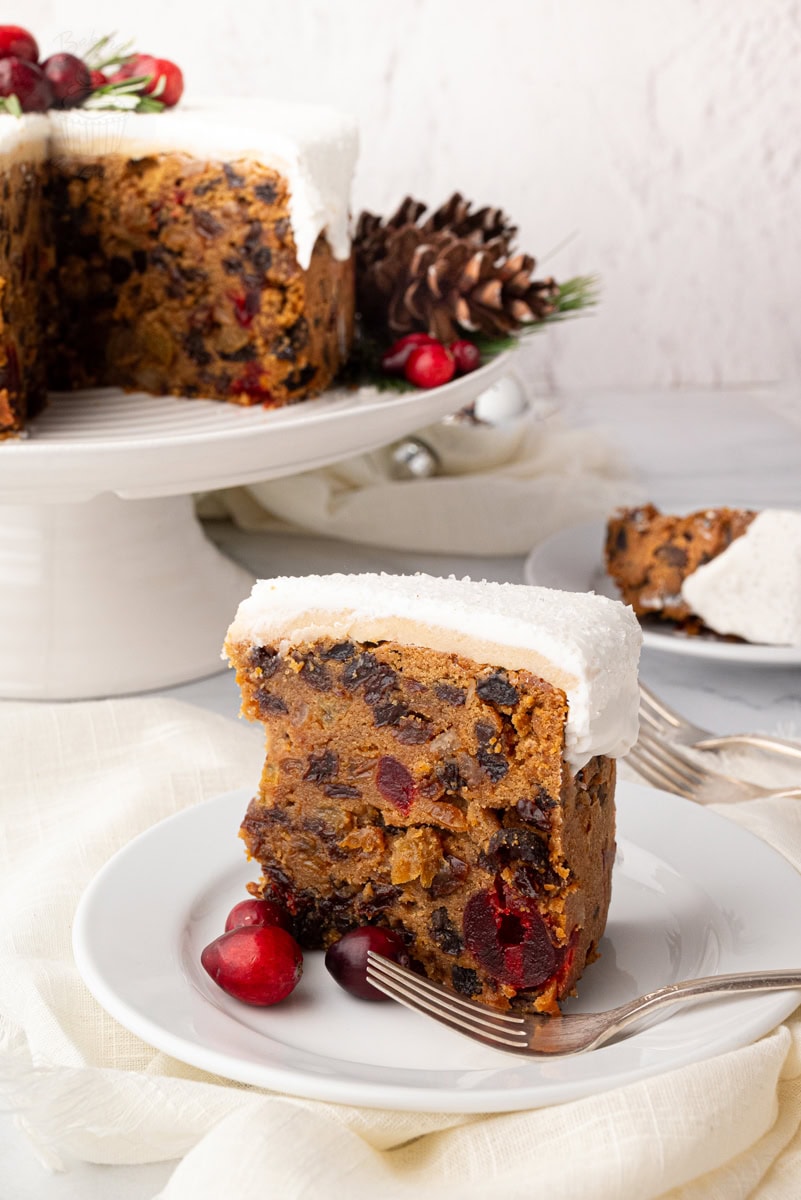
Preparations:
There are a few bits of prep work required when making your Christmas Cake. Firstly, the soaking of your dried fruit.
The purpose of this is to add some moisture, as well as flavour. A fruit Christmas Cake is baked at a low temperature for a number of hours, meaning your cake could easily dry out. “Feeding” your cake over a number of weeks after baking can help remedy this to an extent, but it’s much better to avoid a dry Christmas cake than it is to fix one.
You want to soak your fruit for a day or two before you plan to make your Christmas cake. Using a large bowl, weigh out your dried fruit before pouring your orange juice or brandy over the top of it. Give it all a good stir, cover your bowl with cling film, and leave it somewhere safe. When you come to bake your cake, your fruit should look a little plumper, and the majority of the liquid will have been absorbed.

And before you move on to the next stage of baking your Christmas cake, you’ll want to prepare your tin. The recipe card has the quantities for an 8-inch round cake tin, but you can use my Christmas Cake Quantities Guide if you are using a different-sized tin. A loose-bottom tin is preferable, and since this is a tall cake, you’ll want quite a deep cake tin too – if you only have shallow tins, you can use the quantities for a smaller cake, or simply make two cakes.
You’ll start by greasing your tin and lining it with some greaseproof paper. You also want to have some brown packing paper (or something along those lines) ready to use. This is to wrap around the outside of your tin whilst it bakes, so be sure it is a sufficient length of paper, and you ideally want to be able to fold it over itself and still be a couple of inches taller than your cake tin. You will also need some string to tie your paper in place, and a spare piece of greaseproof paper – big enough to cover the top of your cake.
When you have your cake mixed up, you will spoon it into your pre-lined tin. Once you have smoothed your cake into the tin, you want to wrap your packing paper around the outside of your cake tin. Use your string to secure the paper in place. Dampen your spare piece of greaseproof paper (either by gently holding it under a slowly running tap or dipping it into a tray of water), then carefully wring out any excess water before draping it over the top of your cake.
But why do we wrap a Christmas cake tin in brown paper and top it with some extra greaseproof paper?
Wrapping the tin in brown paper helps slow the baking of the cake to a more steady temperature, avoiding the outside of the cake being overdone (or worse, burnt) while the inside is still raw. And the wet greaseproof paper on top works in a similar way, whilst also trapping some steam within the top of the cake, meaning a moister finish, a lower chance of burning and less cracking on the top.


Tips for Traditional Christmas Cake:
• This recipe is for an 8-inch round cake that requires a deep cake tin. I use a Masterclass 20cm/8-inch Deep Cake Tin and can highly recommend it. If you don’t want as deep a cake (like the one pictured), use the quantities for a 7-inch round cake. You will find these in my FREE Christmas Cake Ingredients Quantities Guide.
• Line the tin well: A Christmas Cake has a long bake, so double-line your tin with baking paper and wrap the outside with brown paper to protect the cake and prevent over-browning. The packing paper from your Amazon parcels is a great “free” alternative to the brown parcel paper needed to wrap your cake tin for baking.
• The right string matters: Be sure to use a cotton string, as opposed to nylon, when it comes to wrapping your cake tin for baking. The latter has a habit of melting!
• Pop the tin on a tray: When it comes to baking your cake, place your cake tin on top of a flat tray (as opposed to directly on the oven shelf). This will help protect the bottom of the cake from burning. Plus it can make removing your cake from the oven a little easier.
• Don’t rush the bake: Low and slow is essential for the dense fruit mixture to cook evenly – not too much, not too little.
• Allow to cool fully in the tin: The cake continues to set as it cools, so leave it cool completely before attempting to remove it.
• Feeding enriches flavour: But it isn’t strictly necessary. You can use brandy, rum, whisky, or orange juice for an alcohol-free version. Or wrap your cake until you’re ready to decorate and let the flavours mature as they are.
• Store properly: A cool, dark place is key, especially in warm climates. Cover with greaseproof paper, wrap in cling film and tin foil, or keep wrapped in the greaseproof paper and store in a cake tub or tin.

Free Ingredient Quantities Guide

Wanting a smaller or bigger Christmas Cake?
Grab a copy of my FREE Ingredients Quantities Guide!
You’ll find the ingredient amounts for 6, 7, 8 and 9-inch Christmas Cakes, as well as the adjusted baking times.
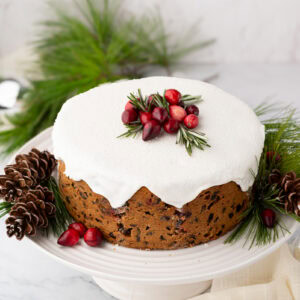
EQUIPMENT
- 8 inch Cake Tin (or your chosen size)
INGREDIENTS
- 450 g Currants
- 200 g Sultanas
- 200 g Seedless Raisins
- 150 g Glace Cherries (Candied Cherries) (halved)
- 75 g Dried Mixed Peel (Candied Mixed Peel)
- Zest of 1 Orange
- 100-200 ml Orange Juice or Brandy
- 275 g Butter or Margarine
- 275 g Soft Dark Brown Sugar
- 5 Free-range Eggs
- 75 g Ground Almonds
- 350 g Plain Flour (All-purpose Flour)
- 1 tsp Mixed Spice (Pumpkin Spice)
- 1 tsp Ground Cinnamon
INSTRUCTIONS
Pre-soak Your Fruit:
- In a large bowl, weigh out your currants, sultanas, raisins, glace cherries, mixed peel and orange zest. Pour over your brandy/orange juice and give everything a good mix. Cover the bowl and leave in a safe place to soak overnight.
The Next Day:
- Preheat your oven to 150°c (130°c for fan-assisted ovens, Gas Mark 2 or 300°F). Grease and line your 8 inch cake tin with grease proof paper and set aside.
- In a large bowl (separate to the one you have your fruit soaking), cream together your butter/margarine and sugar. Add your eggs, one at a time, ensuring each is mixed through before adding the next. Mix through your ground almonds.
- Sift in your flour, mixed spice and cinnamon, before mixing together to create a somewhat thick batter.
- Mix your cake batter with your soaked dried fruit, ensuring all the fruit is coated. Transfer the mixture to your pre-lined cake tin, spreading to the edges. Using your spoon, create a slight dip in the centre of the cake (this helps prevent it rising too much).
- Wrap your cake tin brown parcel paper, secured with string. And cover the top of your cake with a dampened piece of greaseproof paper. Pop your Christmas cake onto a oven tray (as opposed to directly on the oven shelf) and into your pre-heated oven.
- Bake for 3½-4 hours. Check your cake after 3 hours and if it looks like it is baking quicker than expected, turn down your oven a little. Depending on your oven, your cake should be ready after [around] 3½-4 hours baking but you can insert a skewer into the middle of the cake to check – if it comes out clean, your cake is baked through.
- Remove your cake from the oven and allow to cool completely whilst still in it's tin. Once completely cool, remove the cake from the tin but keep the greaseproof lining on the cake. Cover the top of the cake with some extra greaseproof paper, and wrap well in cling film and tin foil, placing your cake somewhere safe to mature before decorating for Christmas.
- If you wish to feed your cake, keep it well wrapped for a couple of weeks before unwrapping and poking a few holes into the top. Brush the cake with some extra brandy or orange juice* before wrapping and storing the cake again. You can repeat this process a couple of times, if you wish. Try not to feed your cake for at least a week before you plan to decorate.*Exercise caution when using orange juice to feed a Christmas cake. Unlike alcohol, it will not be sterile and could cause your cake to mould if overfed or stored incorrectly.
To Decorate:
- You can finish your Christmas cake with a layer of marzipan, followed by a layer of fondant icing or royal icing, and top with whatever décor you desire.
IMPORTANT NOTE:
All my recipes are developed using a digital scale and the metric system (grams and millilitres). Cup measurements are available as a conversion but these, unfortunately, won’t always be as accurate. For best results, I always recommend baking with a digital scale.
RECIPE NOTES:
Free Ingredient Quantities Guide

Wanting a smaller or bigger Christmas Cake?
Grab a copy of my FREE Ingredients Quantities Guide!
You’ll find the ingredient amounts for 6, 7, 8 and 9-inch Christmas Cakes, as well as the adjusted baking times.
A British Christmas Cake is a rich, dark, traditional fruit cake made with dried fruit, warm spices, brown sugar, and often a splash of brandy or whisky. It’s baked slowly, stored for several weeks (or longer), and can be “fed” with alcohol or fruit juice to deepen the flavour over time.
Unlike lighter American-style holiday cakes, a British Christmas Cake is dense, moist, and long-lasting, thanks to its high fruit content and slow baking method. It’s usually finished with a layer of marzipan and either fondant or royal icing, giving it that classic festive look.
A traditional Christmas Cake can be made well ahead of the big day – anywhere from 4 to 12 weeks in advance! The flavours mature beautifully over time, especially if you’re feeding the cake with brandy or whisky. That said, this recipe is wonderfully forgiving, and you can still make it much closer to Christmas and get a deliciously rich fruit cake. If you’re short on time, simply skip the feeding.
Yes! This is a brilliant alcohol-free Christmas Cake option. Instead of brandy or whisky, you can soak and feed the fruit with orange juice, apple juice, strong tea, or even cranberry juice. The cake will still be moist, rich, and full of traditional Christmas flavour, making it perfect for families, children, and anyone who prefers a non-alcoholic fruit cake.
A traditional Christmas Cake has a long, slow bake, which can cause the outer edges to brown too quickly. By wrapping the cake tin in a layer of baking paper and brown paper, you protect the sides and base from overbaking. This also helps the fruit cake bake evenly, prevents it from drying out, and ensures you get that classic moist texture right through. It’s a little extra step, but it makes a big difference to a classic Christmas Cake.
The best fruit for a traditional Christmas Cake is a mix of dried vine fruits such as raisins, sultanas, and currants, along with some glacé cherries and mixed peel. These give the cake its classic richness and moist texture.
You can also add extras depending on what you like – dried apricots, prunes, dates, or cranberries all work well. Just be sure the total weight of fruit stays the same as the recipe.
A Christmas Cake may sink for a few reasons, but the good news is it’s easy to avoid. The most common cause is opening the oven door too early, so keep it closed for at least the first 3 hours. This is a long, slow bake, and the temperature needs to stay steady.
It also helps to make sure your butter/margarine and sugar are properly creamed, your eggs are added gradually, and your batter isn’t overmixed once the flour goes in. Too much rising agent can also cause sinking, but this recipe uses the traditional no-raising-agent method, which gives a beautifully even bake.
Finally, always line and wrap your cake tin. The slow, even heat from proper wrapping prevents the sides from baking too fast, leaving the middle lagging behind.
You can freeze a Christmas Cake, and it freezes beautifully, but it’s not always necessary. A traditional British fruit cake is designed to keep for a long time, thanks to its high fruit content and slow baking. In fact, this is the very recipe my Mum used for wedding cakes, where one of the tiers was often saved for the couple’s first child’s christening – sometimes years later!
That said, safety first. If you plan to store your cake for more than a couple of months, freezing is the most sensible option. Once the cake is completely cool, wrap it tightly in greaseproof paper, then foil, and pop it into an airtight container or freezer bag. It will keep well in the freezer for up to 6 months. When you’re ready to use it, thaw the cake overnight at room temperature before adding marzipan and icing.
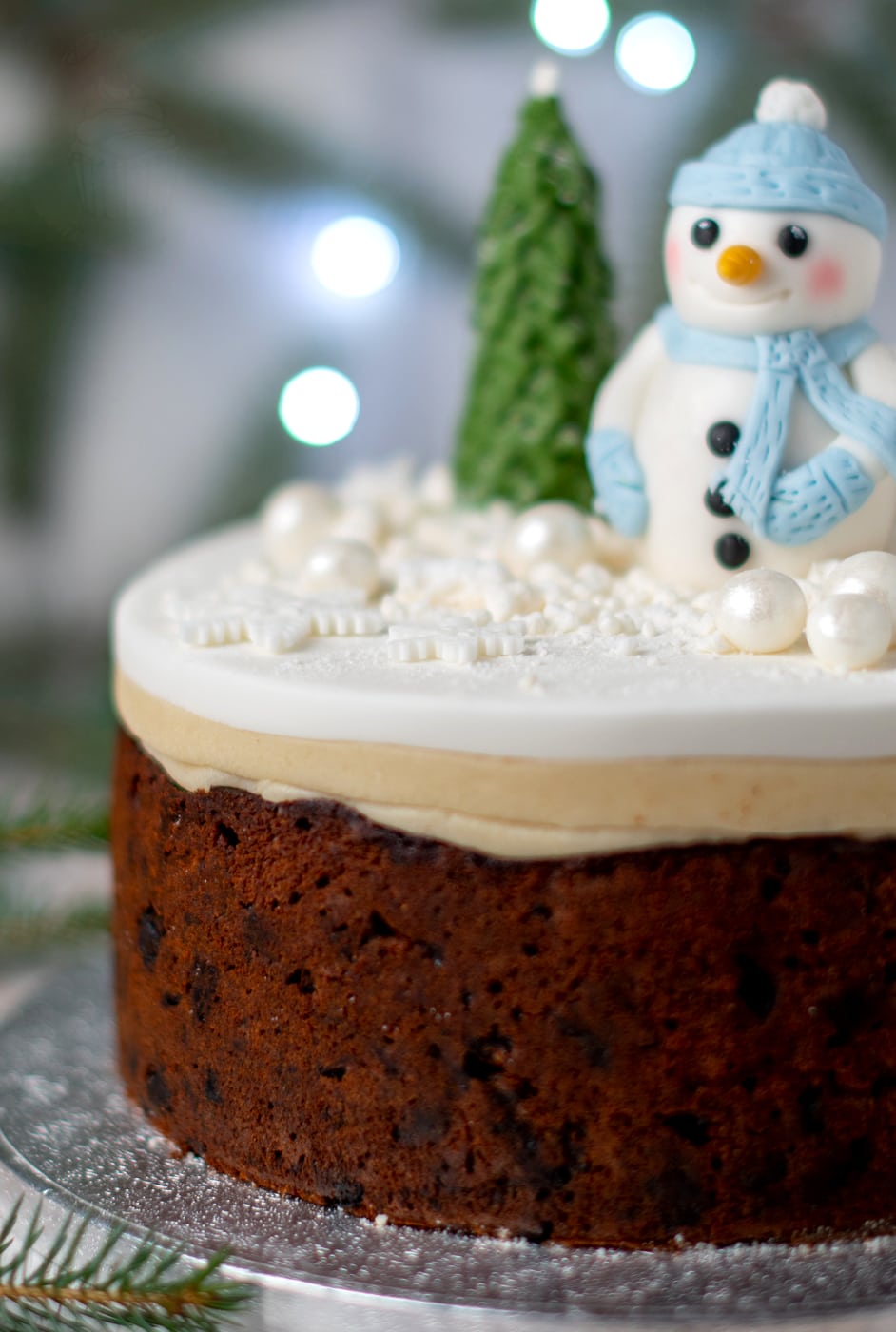
Originally published in November 2022. Updated in November 2025.
Thank you to Naomi Seiler for creating the updated photos.


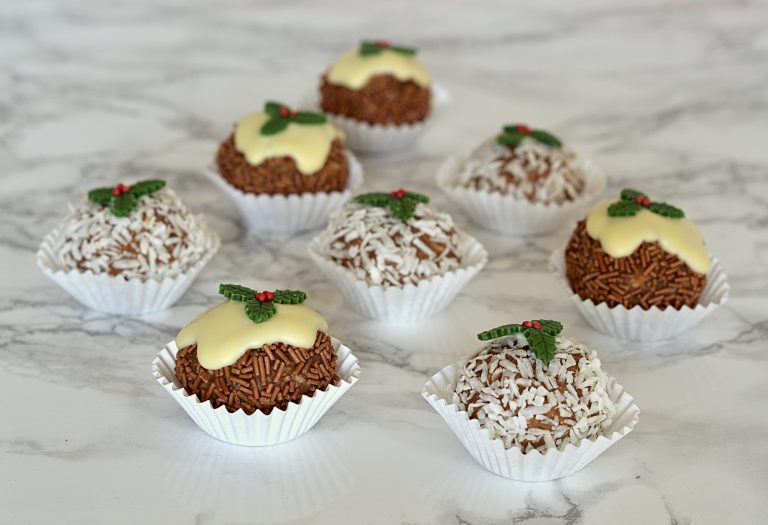



Very nice and knowledgeable.
Great receipe. Very similar to my father’s receipe which I followed. My father has passed on and it has been years since I have baked a Christmas cake as none of my children like cake especially fruit cake. They have all left home and have their own families. You have inspired me to bake a cake this year.
Just made this cake, about to take out of the oven in around 10 minutes. Used ground Walnuts instead of almonds and my fruit was pre-soaked in Whisky and Sherry. I will wrap it for 2 weeks and feed it with a bit more whisky before final wrap and decor. Fingers crossed will taste as good as it looks and Smells.
This is the best and truly tastiest ever Christmas cake anyone will ever enjoy as it is a classic and I have had the pleasure in seeing the process done for not just Christmas but also for Wedding cakes. I was looking to fine this original recipe that my mother used to create every year with the rest process thereafter then soaking with rum or brandy. “Delicious”
Love it
The information so helpful and the tips about wrapping the tin with brown paper explained in such a good fashion. Although I said I would not make a cake this year I will probably make yours